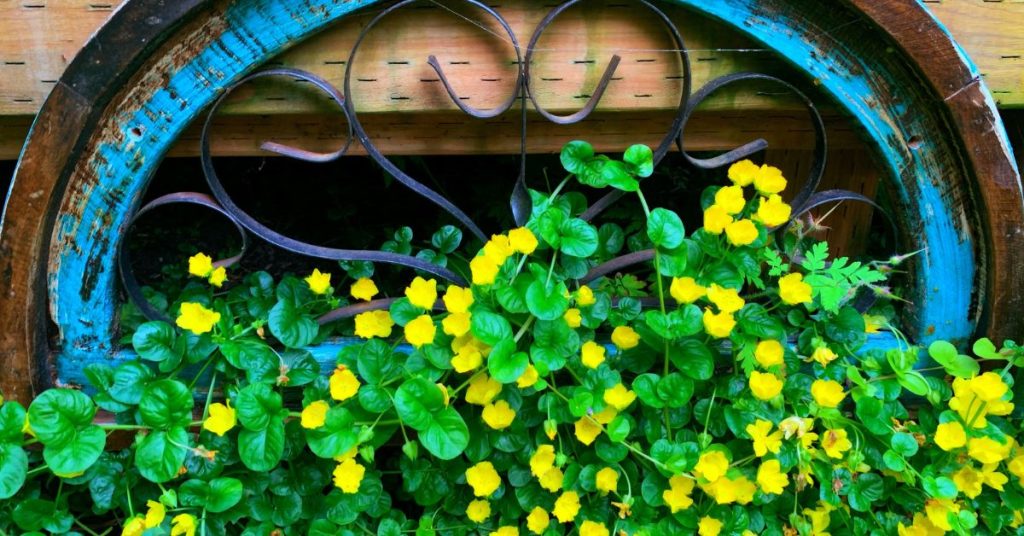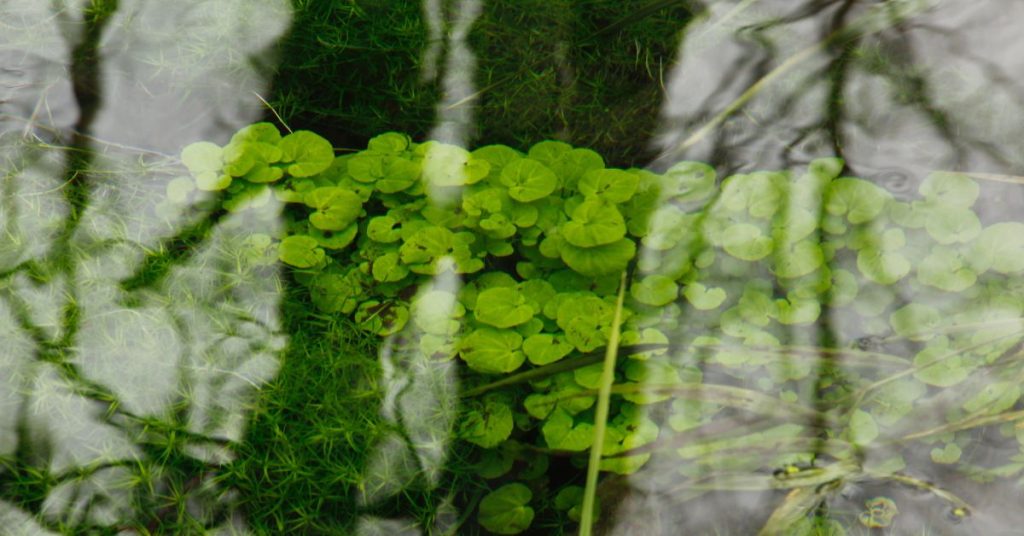In and around your pond and waterfall, Creeping Jenny is a fantastic ground cover that may be utilized to hide the rocks. The rounder leaves that form a dense chain of foliage along the stems are pretty attractive. Your pond will get more attractive when falling down a waterfall or tumbling over the edge of a container garden; it looks stunning.
Its development and spread are substantially slowed when the soil is dry and insufficient. It’s a fantastic choice if you’re looking for a plant that can quickly cover bare spots around a pond or water garden, as it does.
When fully grown, Creeping Jenny can grow to be 2-6 inches tall and up to 12 inches broad in a season. Creeping Jenny is famous among gardeners because it adds interest to the bog section of your pond by giving textural interest and a fantastic groundcover.
Creeping Jenny is a simple plant to propagate because it naturally grows by both seeds and roots and can be quickly established in water. This makes it a good choice for beginners. The growth method is straightforward; all that is required is to establish new plants by digging up a section of an existing patch, separating them, and planting them in new soil.
We will give you more information about planting Creeping Jenny with this addition. So don’t go anywhere. In this article, we will show the process of planting. So without wasting time, let’s get started.

When planting creeping Jenny, there are a few things to keep in mind
The things that have to keep in mind are there have some recommendations that might be suitable for giving your Creeping Jenny a healthy and peaceful condition-
- Creeping Jenny requires soil that is regularly damp but not soggy. Often thrive in moist, low-lying regions of the garden where there is an opportunity for them to expand without interfering with nearby plants’ growth and development. If the soil is soggy or wet, your Creeping Jenny may suffer from fungal problems. While the plant can flourish as a submerged aquatic plant, it must learn to adapt to its new environment but don’t give your plant wet soil after planting.
- Allowing Creeping Jenny flowers to dry up between waterings is not recommended. When it comes to watering requirements, Creeping Jenny prefers damp soil conditions. It is critical to avoid allowing the soil to become entirely dry. It is essential to ensure that the soil drains adequately so that all excess water may pass through and your plants do not become soggy.
- Another thing to keep in mind while planting Creeping Jenny in the ground is that it should be spaced 12 to 18 inches away from the other plants in your garden. With its rapid growth, this low-growing creeper has the potential to cause damage to other plants by choking their roots.
- Creeping Jenny likes sandy, loamy, or clay soils instead of other types of soil. The addition of loamy soil is our exceptional advice. Because loam soils have better drainage and infiltration of water than sandy soils, they are generally considered more fertile, moist, and humus-rich. However, pay close attention to the soil to ensure that it drains properly to prevent the growth of fungal diseases.
- Creeping Jenny does best in full sun to medium shade but may tolerate little shade. The colour of the leaves will vary depending on how much sunlight the plant receives, with golden yellow leaves in full sun and chartreuse green leaves in partial shade. In hot areas, though, the afternoon light may make its leaves turn white. Choose a location where your Creeping Jenny will receive plenty of morning sun to ensure the most fabulous colour.
- Creeping Jenny may thrive in various soil types, including acidic, alkaline, and neutral soils, but it likes a pH of 6-7.8. The pH of the soil is vital for the growth of your Creeping Jenny because it controls various soil parameters that affect plant growth, including soil bacteria, nutrient leaching, nutrient availability, toxic substances, and the structure of the soil.
How To Plant Creeping Jenny
Step 1: Germinate The Seeds
Because of its hardiness, creeping Jenny is a simple plant to propagate from seed. Creating a germination set-up in a greenhouse or a protected section of your yard is essential to producing creeping jenny from seed. Ideally, this should be completed during the spring or summer months.
In pots submerged in a few inches of water, don’t forget to use clean, healthy soil to guarantee that the soil remains moist throughout the germination stage. But be concerned. According to the USDA, the soil should be moist but not saturated with water.
Creeping Jenny seeds demand significantly more water than other types of seeds. As soon as a seed is exposed to the appropriate conditions, water and oxygen are absorbed via the seed coat, causing the embryo cells to grow in size. It is possible that germination will not occur if there is not enough oxygen present.
Step 2: Transfer Germinated Plant To Another Individual Pot or Area
Once the seedlings are grown enough to handle, transplant them into individual pots or containers where they can be spaced apart as much as possible. When planting, it is preferable to add the plant to each planting container in a loose manner rather than tightly.
Feed the bottom half of the planting media with fertiliser, then set the plant in the pot, making sure it is centred in the pot and the roots are spread over the planting material. It is necessary to apply additional planting material up to 2/3 of the way up the plant so that the stems and roots can extend as far as 1-2 inches below the surface of the planting medium.
Step 3: Give Them Support As Hanging Plant
Creeping Jenny, commonly known as moneywort, is a long, creeping plant that can quickly spread. Whenever it is grown in a container indoors, the plant’s stems will crawl and trail over the edges of the container, making it ideal for putting in a hanging basket or container.
Creeping Jenny in pots can also be grown in a standing pot supported by a shelf or other structure. Once it has established itself, it can be difficult to remove, and it will crowd out or strangle plants that come into its path since it enjoys tying another individual to its branches.
Once it has established itself, this plant grows particularly well indoors in a hanging planter or basket, either alone or in a grouping with other varieties of plants. As a result, it’s recommended to use them as fillers between waterfalls or rocks, where they may fill in the gaps, or as a trailing plant in hanging baskets, window boxes, or other containers where they can trail.

FAQs
Can You Plant Creeping Jenny In Water?
To thrive, Creeping Jenny requires extremely wet soil or water at least one inch deep, making it a perfect choice for use as a marginal plant in your water garden. Highly wet soil or water with a depth of approximately 2 inches is known to be ideal for this pond plant’s growth. Creeping Jenny is an excellent marginal plant for your water garden, so consider it if you’re seeking one.
Does Creeping Jenny need sun or shade?
Creeping Jenny does best in full sun to medium shade but may tolerate little shade. The colour of the leaves will vary according to how much sunlight is received by the plant: golden yellow in full sun, chartreuse green in partial shade, and so on.
How Fast Will Creeping Jenny Need To Grow?
It should be planted 12 to 18 inches apart due to its tendency to spread quickly. This dense carpet will develop swiftly to form anywhere from 4 to 8 inches in height, depending on how much sunlight they receive. Planting Creeping Jenny in the early spring is the best way to ensure that it produces lovely summer blossoms, although it will take root whenever the weather is mild and regular water is available.
Do fish eat creeping Jenny?
A wide variety of tiny creatures, mainly slugs and bug larvae, can be found grazing on the foliage of creeping jenny from time to time. Fish and other pond residents may take a nibble or two of this plant, but it is not typically recognised as a food source.
Conclusion
These are the ways to plant the Creeping Jenny. Now it’s your time to follow all the maintenance, recommendations, and advice. After that, leave your questions in the comment section. We will try to give you an answer as soon as possible.
Good Luck!!


